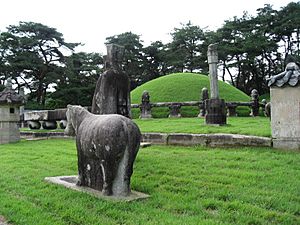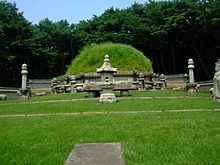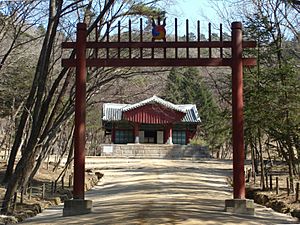Royal Tombs of the Joseon dynasty facts for kids
Quick facts for kids Royal Tombs of the Joseon dynasty |
|
|---|---|

Yeongneung
|
|
| Location | South Korea |
| Built | Joseon dynasty |
| Governing body | Cultural Heritage Administration of Korea |
| Type | Cultural |
| Criteria | iii, iv, vi |
| Designated | 2009 (33rd session) |
| Reference no. | 1319 |
| Region | Asia and Australasia |
| Lua error in Module:Location_map at line 420: attempt to index field 'wikibase' (a nil value). | |
| Korean name | |
| Hangul | |
|---|---|
| Hanja | |
| Revised Romanization | Joseon Wangneung |
| McCune–Reischauer | Chosŏn Wangnŭng |
The Royal Tombs of the Joseon dynasty are 40 special burial sites for the kings, queens, and other royal family members of the Joseon kingdom. This kingdom ruled Korea from 1392 to 1910. These tombs are found in 18 different places across the Korean Peninsula. They were built to show respect for ancestors and their achievements. They also helped show the power of the royal family. Since 2009, these tombs have been a UNESCO World Heritage Site. Two other Joseon tombs are in Kaesong, North Korea, but they are not part of the World Heritage Site.
Contents
- What Makes Up a Royal Tomb?
- Types of Royal Tombs
- Dongguneung Cluster (동구릉)
- Gwangneung (광릉)
- Heoninneung (헌인릉)
- Hongyuneung (홍유릉)
- Jangneung (Gimpo) (김포 장릉)
- Jangneung (Paju) (파주 장릉)
- Jangneung (Yeongwol) (영월 장릉)
- Jeongneung (정릉)
- Onneung (온릉)
- Paju Samneung Cluster (파주 삼릉)
- Seonjeongneung (선정릉)
- Seooneung Cluster (서오릉)
- Seosamneung Cluster (서삼릉)
- Taegangneung (태강릉)
- Uineung (의릉)
- Yeongneung (영릉)
- Yonggeonneung (융건릉)
- See also
What Makes Up a Royal Tomb?
Royal tombs are usually divided into three main areas. Each area had a special purpose.
The Entrance Area
This is the first part you see. It's like a meeting point between the living and the dead. The area around the Hongsalmun gate was for people to gather.
The Middle Area
This space is between the everyday world and the sacred burial ground. It's where the spirits of the kings and queens were thought to meet people who came to worship them. This area includes the Jeongjagak shrine, the Subokbang building, and the Suragan building.
The Sacred Burial Ground
This is the most important part. It holds the actual grave mounds. This area also has protective walls and other stone structures.
Important Structures at the Tombs
Many different structures make up a royal tomb:
- Gokjang – These are five-sided walls that surround the grave mound. They protect the sacred area.
- Seokho – This is a stone tiger statue. It acts as a guardian for the Bongbun (the burial mound).
- Seogyang – This is a stone sheep statue. It was believed to scare away evil spirits and pray for the souls of the dead.
- Mangjuseok – These are a pair of stone pillars. They stand on both sides of the burial mound.
- Bongbun – This is the actual mound where the king or queen's body rests. It's also called Neungchim or Neungsang.
- Nanganseok – This is a stone fence-like structure. It protects the Byeongpungseok (a stone screen).
- Honnyuseok – This is a rectangular stone in front of the mound. People believed it invited the soul to come out.
- Muninseok – These are statues of scholars. They are placed on the left and right sides of the Jangmyeongdeung lantern.
- Jangmyeongdeung – This is a stone lantern. It was meant to comfort the soul and offer blessings.
- Seongma – This is a stone horse statue.
- Muinseok – This is a statue of a soldier. It's placed below the Muninseok and is said to guard the king.
- Yegam – This is a small area behind the Jeongjagak. It was used to burn written prayers after a burial ceremony.
- Bigak – This is a building with a stone monument. The names of the king and queen are written on the front. The king's achievements are listed on the back.
- Jeongjagak – This is where memorial services were held for the deceased.
- Chamdo – These are two stone paths leading to the Jeongjagak. The higher path is called Sindo (Path of the Gods). The lower path is called Eodo (Path of the King). Visitors were only allowed to use the Eodo path.
- Suragan – This is where food for the memorial services was prepared.
- Subokbang – This was the living area for the officer who guarded the tomb.
- Baewi – This is where the king and officials knelt to honor the dead king. It's also called Panwi or Eobaseok.
- Hongsalmun – This is a gate with two red cylindrical pillars. It marks the entrance to the sacred area.
- Byeongpungseok – This is a stone screen placed underneath and around the Bongbun to protect it.
Types of Royal Tombs
Joseon royal tombs are grouped into different types based on who is buried there:
- Neung (릉) – These tombs hold kings, queens, and those who were given the title of king or queen after they died.
- Won (원) – These tombs are for crown princes and their wives.
- Myo (묘) – These tombs are for other members of the royal family.
There are 40 neung-type and 13 won-type tombs, making a total of 53 royal tombs. Many of these tombs are spread out, some as far as 40 kilometers from Seoul. For example, Jangneung is in Yeongwol, and Yeongneung is in Yeoju. Some tombs are for individuals, while others are for family groups.
The design of Joseon royal tombs followed rules from old Chinese Confucian books like the Book of Rites. Many things were considered when choosing a tomb location. These included how far it was from Seoul, its distance from other royal tombs, how easy it was to get to, and Korean traditions of pungsu (which is about how land features affect luck). The tomb builders also thought about traditional Korean burial customs and the natural environment.
Two more royal tombs from the Joseon Dynasty are in Kaesong, North Korea. They are Jeneung (제릉), the tomb of Queen Sinui (King Taejo's first wife), and Huneung (후릉), the tombs of King Jeongjong and Queen Jeongan.
Dongguneung Cluster (동구릉)
37°37′11″N 127°07′53″E / 37.61972°N 127.13139°E
This group of tombs is a great example of how tomb architecture changed over 500 years in the Joseon era. It holds nine neung-type tombs, burying seven kings and ten queens. The most famous tomb here is Geonwonneung (건원릉), which belongs to King Taejo, the founder of the Joseon dynasty. This cluster is located in Guri, Gyeonggi Province.
Gwangneung (광릉)
37°45′08″N 127°10′38″E / 37.75222°N 127.17722°E
Gwangneung is a pair of tombs in Namyangju, Gyeonggi Province. They hold the remains of King Sejo and his wife, Queen Jeonghui. These tombs were built in 1468 and 1483. Gwangneung is important because it shows new ways of building royal tombs. For example, screening rocks were not used, and quicklime was used instead of an outer coffin stone. Also, only one T-shaped ritual shrine was built for both burial mounds. These changes showed a new, simpler style that influenced later tomb construction.
Heoninneung (헌인릉)
Heonneung: 37°27′58″N 127°04′59″E / 37.46611°N 127.08306°E Inneung: 37°27′58″N 127°04′50″E / 37.46611°N 127.08056°E
This tomb site is in southern Seoul, at the bottom of Daemosan Mountain. Heonneung is a pair of tombs for Taejong of Joseon and Queen Wongyeong. Inneung is a single mound about 200 meters west. It holds the remains of King Sunjo and Queen Sunwon.
Hongyuneung (홍유릉)
Hongneung: 37°37′52″N 127°12′45″E / 37.63111°N 127.21250°E Yuneung: 37°37′50″N 127°12′33″E / 37.63056°N 127.20917°E Yeongwon: 37°37′46″N 127°12′56″E / 37.62944°N 127.21556°E
The style of these two main tombs shows the big political changes in Korea during the end of the Joseon dynasty. When the Korean Empire was declared, the tombs of the last two rulers, Emperor Gojong and Emperor Sunjong, were designed to show their new higher status. Hongneung holds Emperor Gojong and Empress Myeongseong. Yuneung holds Emperor Sunjong and his two wives. These tombs are in Namyangju, east of Seoul.
Jangneung (Gimpo) (김포 장릉)
37°36′47″N 126°42′40″E / 37.61306°N 126.71111°E
There are three Joseon tombs named Jangneung. This specific double tomb is in Gimpo, Gyeonggi Province. It holds the remains of Prince Jeongwon (who was later honored as King Wonjong) and Queen Inheon. They were the parents of King Injo.
Jangneung (Paju) (파주 장릉)
37°46′25″N 126°42′29″E / 37.77361°N 126.70806°E
This tomb is in Paju, Gyeonggi Province. It is near where the Imjin and Han rivers meet. It holds the remains of King Injo and his first wife, Queen Inyeol.
Jangneung (Yeongwol) (영월 장릉)
37°11′51″N 128°27′11″E / 37.19750°N 128.45306°E
This tomb is in Yeongwol, Gangwon Province. It is the furthest from the capital city. It holds the remains of King Danjong.
Jeongneung (정릉)
37°36′08″N 127°00′21″E / 37.60222°N 127.00583°E
This Jeongneung tomb is in Seoul, north of the Han River. It holds the remains of Queen Sindeok, the second wife of King Taejo. It is not the same as the more famous Jeongneung near Bukhansan Mountain.
Onneung (온릉)
37°43′13″N 126°57′04″E / 37.72028°N 126.95111°E
Onneung is a tomb in Yangju, Gyeonggi Province. It holds the remains of Queen Dangyeong, the first wife of King Jungjong.
Paju Samneung Cluster (파주 삼릉)
Gongneung: 37°44′45″N 126°49′48″E / 37.74583°N 126.83000°E Sunneung: 37°44′37″N 126°50′11″E / 37.74361°N 126.83639°E Yeongneung: 37°44′33″N 126°50′01″E / 37.74250°N 126.83361°E
This group of tombs is in Paju, Gyeonggi Province. It includes Gongneung (공릉) for Queen Jangsun, Sunneung (술릉) for Queen Gonghye, and Yeongneung (영릉) for Crown Prince Hyojang (later King Jinjong) and Queen Hyosun. Note that this Yeongneung is different from King Sejong's tomb in Yeoju.
Seonjeongneung (선정릉)
Seonneung: 37°30′32″N 127°02′44″E / 37.50889°N 127.04556°E Jeongneung: 37°30′32″N 127°03′07″E / 37.50889°N 127.05194°E
Located in southern Seoul, Jeongneung is the tomb of King Jungjong. Seonneung holds the remains of King Seongjong and his third wife, Queen Jeonghyeon. These tombs are in a park, close to Seolleung Station.
Seooneung Cluster (서오릉)
Changneung: 37°38′09″N 126°53′42″E / 37.63583°N 126.89500°E Hongneung: 37°37′58″N 126°53′38″E / 37.63278°N 126.89389°E Gyeongneung: 37°37′47″N 126°53′38″E / 37.62972°N 126.89389°E Ingneung: 37°37′47″N 126°54′02″E / 37.62972°N 126.90056°E Myeongneung: 37°37′31″N 126°54′04″E / 37.62528°N 126.90111°E Daebinmyo: 37°37′49″N 126°53′32″E / 37.63028°N 126.89222°E Sugyeongwon: 37°37′38″N 126°54′02″E / 37.62722°N 126.90056°E Sunchangwon: 37°37′45″N 126°53′50″E / 37.62917°N 126.89722°E
This group of tombs is in Goyang, Gyeonggi Province. It includes Changneung (창릉) for King Yejong and his second wife, Hongneung (홍릉) for Queen Jeongseong, Gyeongneung (경릉) for Crown Prince Uigyeong and Queen Sohye, Ingneung (익릉) for Queen Ingyeong, and Myeongneung (명릉) for King Sukjong and his second and third wives. Other notable tombs here include Daebinmyo (대빈묘) for Royal Noble Consort Huibin Jang, and Sugyeongwon (수경원) for Royal Noble Consort Yeongbin Yi.
Seosamneung Cluster (서삼릉)
Huineung: 37°39′49″N 126°52′14″E / 37.66361°N 126.87056°E Hyoneung: 37°39′53″N 126°51′51″E / 37.66472°N 126.86417°E Yeneung: 37°39′56″N 126°52′07″E / 37.66556°N 126.86861°E Hoimyo: 37°39′58″N 126°51′32″E / 37.66611°N 126.85889°E Hyochangwon: 37°39′50″N 126°52′02″E / 37.66389°N 126.86722°E Uiryeongwon: 37°39′50″N 126°52′02″E / 37.66389°N 126.86722°E
Seosamneung (meaning "The Three Western Tombs") is in Goyang, Gyeonggi Province, about 20 km from Seoul. This cluster holds Huineung (휘릉) for Queen Janggyeong, Hyoneung (효릉) for King Injong and Queen Inseong, and Yeneung (예릉) for King Cheoljong and Queen Cheorin. There are also about fifty other tombs here. These include Hoimyo (회묘) for Deposed Queen Yun, and Hyochangwon (효창원) for Crown Prince Munhyo. This cluster also gathers many taesil monuments, which once held the royal placenta and umbilical cords from all over Korea.
Taegangneung (태강릉)
Taeneung: 37°38′05″N 127°05′49″E / 37.63472°N 127.09694°E Gangneung: 37°38′24″N 127°06′19″E / 37.64000°N 127.10528°E
These two tombs are in eastern Seoul, about 1 km apart. Taeneung (태릉) holds the remains of Queen Munjeong. Gangneung (강릉) is the resting place of her son, King Myeongjong, and his wife, Queen Insun.
Uineung (의릉)
37°36′13″N 127°03′25″E / 37.60361°N 127.05694°E
Uineung is a pair of tombs in Seongbuk District, Seoul. They hold the remains of King Gyeonjong and his second wife, Queen Seonui.
Yeongneung (영릉)
Yeongneung (King Hyojong): 37°18′50″N 127°36′32″E / 37.31389°N 127.60889°E Yeongneung (King Sejong): 37°18′29″N 127°36′11″E / 37.30806°N 127.60306°E
These two identically named tombs are in western Yeoju, Gyeonggi Province. Sejong the Great and his wife, Queen Soheon, are buried in a mound surrounded by statues, near a pond and a shrine. King Hyojong’s tomb is in line with his wife’s tomb, Queen Inseon.
Yonggeonneung (융건릉)
Geonneung: 37°12′50″N 126°59′17″E / 37.21389°N 126.98806°E Yongneung: 37°12′42″N 126°59′38″E / 37.21167°N 126.99389°E
Located in a park in Hwaseong, Gyeonggi Province, Yongneung (융릉) is the resting place of Crown Prince Sado and Lady Hyegyeong. Geonneung (건릉) holds the remains of King Jeongjo and Queen Hyoui.
See also
 In Spanish: Tumbas reales de la dinastía Joseon para niños
In Spanish: Tumbas reales de la dinastía Joseon para niños
- Umbilical cord tomb of Taejo of Joseon dynasty
- Cultural Heritage Administration, the group that manages these tombs








